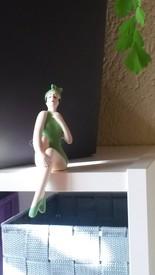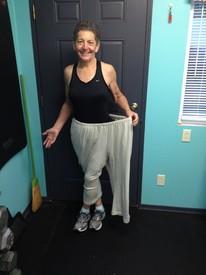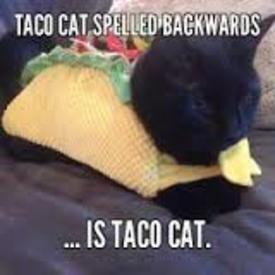Does Celery = Negative Calories? Help Solve an Argument

suzievv
Posts: 410 Member
So I'm having an ongoing discussion with someone about celery. He says that when you eat celery, it has a negative calorie effect because it requires more calories to burn the celery than it does to eat it. I say, it still has calories. If someone sat down and ate 250 cups of celery every day, they would gain weight. Granted, no one would ever do that. I don't know if it's humanly possibly to eat 250 cups of celery every day. But it makes my point (I think).
What do you think? Can anyone help settle this discussion?
What do you think? Can anyone help settle this discussion?
0
Replies
-
-
1
-
ladyreva78 wrote: »
I have his sites bookmarked for when I want a funny read.2 -
Tacklewasher wrote: »ladyreva78 wrote: »
I have his sites bookmarked for when I want a funny read.
I jump around on computers at work (5-6 of them) and I don't have it bookmarked on all of them. (This one being one of them. Or rather... having been one of them... That situation has now been corrected ) 0
) 0 -
No.1
-
Wouldn't water qualify? I mean water has zero calories but surely our bodies burn a few calories processing the water.
If it must be solid to be "food", then ice. Then our bodies would also have to warm it.1 -
From a purely physics point of view, ice goes in at about zero degrees Celsius and comes out at 37 or so degrees, so it must take energy from the body to process it. I did the maths long ago but it didn't inspire me to try an ice diet.
Rather the opposite, I love my tea and I drink it hot. Does that make it more calorific?2 -
skyblueteapot wrote: »From a purely physics point of view, ice goes in at about zero degrees Celsius and comes out at 37 or so degrees, so it must take energy from the body to process it. I did the maths long ago but it didn't inspire me to try an ice diet.
Rather the opposite, I love my tea and I drink it hot. Does that make it more calorific?
Would your body have to cool the tea, just as it must heat the ice?1 -
So I'm having an ongoing discussion with someone about celery. He says that when you eat celery, it has a negative calorie effect because it requires more calories to burn the celery than it does to eat it. I say, it still has calories. If someone sat down and ate 250 cups of celery every day, they would gain weight. Granted, no one would ever do that. I don't know if it's humanly possibly to eat 250 cups of celery every day. But it makes my point (I think).
What do you think? Can anyone help settle this discussion?
To be a negative calorie food, TEF would have to exceed 100% and there is no such food. Celery is definitely a very low calorie food...but it does not have a particularly high TEF...1 -
WALK. AWAY.0
-
Let's really break it down: Using an entry from the MFP database, 100 calories worth of chopped celery is about 6.2 cups. The macro breakdown is 19g carbs, 1g fat, 4g protein. The TEF of carbs is between 5-15%; the TEF of fats is around 2% and the TEF of protein is around 25-30%.
So here's how the net calorie intake would break down:
19g carbs = 76 calories. 76 x 0.15 (TEF) = 11.4 calories to digest/metabolize, leaving a net intake of 64.6 calories.
1g fat = 9 calories. 9 x 0.02 (TEF) = 0.18 calories to digest/metabolize, leaving a net intake of 8.82 calories.
4g protein = 16 calories. 16 x 0.30 (TEF) = 4.8 calories to digest/metabolize, leaving a net intake of 11.2 calories.
So for 100 calories of celery, you used 16.38 calories to digest/metabolize it, leaving you a net caloric intake of 83.62 calories from the original 100.
So it's definitely not a negative calorie food (and there is no such thing as negative calorie foods, as shown in the link provided above).9 -
The only negative calorie food is fingernails. You expend energy growing them, chewing them, digesting them and replacing them. But it only works with your own. Other people's are not negative calorie.8
-
Let's really break it down: Using an entry from the MFP database, 100 calories worth of chopped celery is about 6.2 cups. The macro breakdown is 19g carbs, 1g fat, 4g protein. The TEF of carbs is between 5-15%; the TEF of fats is around 2% and the TEF of protein is around 25-30%.
So here's how the net calorie intake would break down:
19g carbs = 76 calories. 76 x 0.15 (TEF) = 11.4 calories to digest/metabolize, leaving a net intake of 64.6 calories.
1g fat = 9 calories. 9 x 0.02 (TEF) = 0.18 calories to digest/metabolize, leaving a net intake of 8.82 calories.
4g protein = 16 calories. 16 x 0.30 (TEF) = 4.8 calories to digest/metabolize, leaving a net intake of 11.2 calories.
So for 100 calories of celery, you used 16.38 calories to digest/metabolize it, leaving you a net caloric intake of 83.62 calories from the original 100.
So it's definitely not a negative calorie food (and there is no such thing as negative calorie foods, as shown in the link provided above). 11
11 -
It's pseudoscience. If eating only "negative calorie foods" worked, then koalas shouldn't be alive or get any bigger from birth. Koalas only eat eucalyptus leaves and they aren't a notable calorie food.
A.C.E. Certified Personal and Group Fitness Trainer
IDEA Fitness member
Kickboxing Certified Instructor
Been in fitness for 30 years and have studied kinesiology and nutrition 4
4 -
It's pseudoscience. If eating only "negative calorie foods" worked, then koalas shouldn't be alive or get any bigger from birth. Koalas only eat eucalyptus leaves and they aren't a notable calorie food.
A.C.E. Certified Personal and Group Fitness Trainer
IDEA Fitness member
Kickboxing Certified Instructor
Been in fitness for 30 years and have studied kinesiology and nutrition
Got me curious so I looked up the info. From wiki:
Koalas typically inhabit open eucalypt woodlands, and the leaves of these trees make up most of their diet. Because this eucalypt diet has limited nutritional and caloric content, koalas are largely sedentary and sleep up to 20 hours a day.
I suppose if we slept 83% of our lifetime and sat still the remaining, a leafy diet would be sustainably calorie positive.
OP, we're not eating celery for the calories. We're eating it mostly for other benefits. After a certain amount the benefits start to diminish. The more celery we eat the larger the calorie deficit becomes and less sustainable our lives get. That's why no one would ever try it. And those who did wouldn't be around to tell us. That's your proof. You win the argument against that someone.
2 -
Let's really break it down: Using an entry from the MFP database, 100 calories worth of chopped celery is about 6.2 cups. The macro breakdown is 19g carbs, 1g fat, 4g protein. The TEF of carbs is between 5-15%; the TEF of fats is around 2% and the TEF of protein is around 25-30%.
So here's how the net calorie intake would break down:
19g carbs = 76 calories. 76 x 0.15 (TEF) = 11.4 calories to digest/metabolize, leaving a net intake of 64.6 calories.
1g fat = 9 calories. 9 x 0.02 (TEF) = 0.18 calories to digest/metabolize, leaving a net intake of 8.82 calories.
4g protein = 16 calories. 16 x 0.30 (TEF) = 4.8 calories to digest/metabolize, leaving a net intake of 11.2 calories.
So for 100 calories of celery, you used 16.38 calories to digest/metabolize it, leaving you a net caloric intake of 83.62 calories from the original 100.
So it's definitely not a negative calorie food (and there is no such thing as negative calorie foods, as shown in the link provided above).
Hey can you please cite where you found the TEF for carbs, fat, and protein? I have been researching about the thermogenic effect of food for several weeks now. I found a meta analysis that pooled fasting metabolic rates with metabolic rates after eating together, and they developed a model that for every 100 calories you eat your metabolism increases by 1.2 kcal/hr. Source http://www.mdpi.com/2072-6643/8/11/670/htm1 -
THANK YOU, ALL. I knew I was right, and I knew that y'all would help with some good information. I have recited all the info to this dear, misinformed person, and he has owned up to the fact that he was misinformed.5
-
Alatariel75 wrote: »The only negative calorie food is fingernails. You expend energy growing them, chewing them, digesting them and replacing them. But it only works with your own. Other people's are not negative calorie.
Lol.
0 -
Let's really break it down: Using an entry from the MFP database, 100 calories worth of chopped celery is about 6.2 cups. The macro breakdown is 19g carbs, 1g fat, 4g protein. The TEF of carbs is between 5-15%; the TEF of fats is around 2% and the TEF of protein is around 25-30%.
So here's how the net calorie intake would break down:
19g carbs = 76 calories. 76 x 0.15 (TEF) = 11.4 calories to digest/metabolize, leaving a net intake of 64.6 calories.
1g fat = 9 calories. 9 x 0.02 (TEF) = 0.18 calories to digest/metabolize, leaving a net intake of 8.82 calories.
4g protein = 16 calories. 16 x 0.30 (TEF) = 4.8 calories to digest/metabolize, leaving a net intake of 11.2 calories.
So for 100 calories of celery, you used 16.38 calories to digest/metabolize it, leaving you a net caloric intake of 83.62 calories from the original 100.
So it's definitely not a negative calorie food (and there is no such thing as negative calorie foods, as shown in the link provided above).
Hey can you please cite where you found the TEF for carbs, fat, and protein? I have been researching about the thermogenic effect of food for several weeks now. I found a meta analysis that pooled fasting metabolic rates with metabolic rates after eating together, and they developed a model that for every 100 calories you eat your metabolism increases by 1.2 kcal/hr. Source http://www.mdpi.com/2072-6643/8/11/670/htm
Lyle McDonald lays it out and explains it in this article, under the heading "Thermic Effect of Food (TEF)": http://www.bodyrecomposition.com/fat-loss/metabolic-rate-overview.html
(The value I used in the post above for the TEF of carbs was actually optimistically high - Lyle cites it as 5-6%. I've seen other values cited at various places, but they're usually at least somewhat in the same ballpark)0 -
I always think this is an interesting question and depends on your definition of "food". People say "doesn't cold water take calories to process?" Yes, but water isn't "food", by anyone's definition. Defining something as "food" does rather imply it has some calories.Need2Exerc1se wrote: »skyblueteapot wrote: »From a purely physics point of view, ice goes in at about zero degrees Celsius and comes out at 37 or so degrees, so it must take energy from the body to process it. I did the maths long ago but it didn't inspire me to try an ice diet.
Rather the opposite, I love my tea and I drink it hot. Does that make it more calorific?
Would your body have to cool the tea, just as it must heat the ice?
You don't really spend calories to cool down, you just make various changes which vent the heat which has already built up.
Whether hot food and drinks contribute useful energy to the body through heat is going to depend on the ambient temperature. If you're somewhere hot where you are having no trouble maintaining your core temperature and are actually having to work to stay cool, taking in something hot will not contribute energy, it will just add more surplus heat that has to be got rid of. But if your are somewhere cold and are having to burn calories to keep your core temperature up, a hot drink will reduce how many calories you need to burn to do that. In this sense, jumpers and woolly hats and radiators are also "calorific".0 -
Keep talking everyone; I'm nearly there...
For a nerd bag like me, that is as stimulating as it gets.0 -
TerryMyfitbitsnbobs wrote: »Keep talking everyone; I'm nearly there...
For a nerd bag like me, that is as stimulating as it gets.
I am now slightly uncomfortable...2 -
There's no such thing as negative calories. Everything contains calories, you don't really burn of more than what is absorbed. It's a myth. Heck, there's not even such thing as 0 calories. A serving of "zero" cal diet coke can have up to 5 calories in it. It's negligible until consumed at a larger quantity. That being said (I hate celery and don't eat it) but if I did, I would 100% count it toward my daily calories.0
-
SlothLady_97 wrote: »There's no such thing as negative calories. Everything contains calories, you don't really burn of more than what is absorbed. It's a myth. Heck, there's not even such thing as 0 calories. A serving of "zero" cal diet coke can have up to 5 calories in it. It's negligible until consumed at a larger quantity. That being said (I hate celery and don't eat it) but if I did, I would 100% count it toward my daily calories.
Water has no calories1 -
CattOfTheGarage wrote: »I always think this is an interesting question and depends on your definition of "food". People say "doesn't cold water take calories to process?" Yes, but water isn't "food", by anyone's definition. Defining something as "food" does rather imply it has some calories.Need2Exerc1se wrote: »skyblueteapot wrote: »From a purely physics point of view, ice goes in at about zero degrees Celsius and comes out at 37 or so degrees, so it must take energy from the body to process it. I did the maths long ago but it didn't inspire me to try an ice diet.
Rather the opposite, I love my tea and I drink it hot. Does that make it more calorific?
Would your body have to cool the tea, just as it must heat the ice?
You don't really spend calories to cool down, you just make various changes which vent the heat which has already built up.
Whether hot food and drinks contribute useful energy to the body through heat is going to depend on the ambient temperature. If you're somewhere hot where you are having no trouble maintaining your core temperature and are actually having to work to stay cool, taking in something hot will not contribute energy, it will just add more surplus heat that has to be got rid of. But if your are somewhere cold and are having to burn calories to keep your core temperature up, a hot drink will reduce how many calories you need to burn to do that. In this sense, jumpers and woolly hats and radiators are also "calorific".
This part appeals to me, we're freezing over here!0 -
JustMissTracy wrote: »CattOfTheGarage wrote: »I always think this is an interesting question and depends on your definition of "food". People say "doesn't cold water take calories to process?" Yes, but water isn't "food", by anyone's definition. Defining something as "food" does rather imply it has some calories.Need2Exerc1se wrote: »skyblueteapot wrote: »From a purely physics point of view, ice goes in at about zero degrees Celsius and comes out at 37 or so degrees, so it must take energy from the body to process it. I did the maths long ago but it didn't inspire me to try an ice diet.
Rather the opposite, I love my tea and I drink it hot. Does that make it more calorific?
Would your body have to cool the tea, just as it must heat the ice?
You don't really spend calories to cool down, you just make various changes which vent the heat which has already built up.
Whether hot food and drinks contribute useful energy to the body through heat is going to depend on the ambient temperature. If you're somewhere hot where you are having no trouble maintaining your core temperature and are actually having to work to stay cool, taking in something hot will not contribute energy, it will just add more surplus heat that has to be got rid of. But if your are somewhere cold and are having to burn calories to keep your core temperature up, a hot drink will reduce how many calories you need to burn to do that. In this sense, jumpers and woolly hats and radiators are also "calorific".
This part appeals to me, we're freezing over here!
By that measure, I burn more calories sleeping under my heavy blankets because it's cold outside. I like it, but high doubt that would help in any way with my weight goals.0
This discussion has been closed.
Categories
- All Categories
- 1.4M Health, Wellness and Goals
- 398.2K Introduce Yourself
- 44.7K Getting Started
- 261K Health and Weight Loss
- 176.4K Food and Nutrition
- 47.7K Recipes
- 233K Fitness and Exercise
- 462 Sleep, Mindfulness and Overall Wellness
- 6.5K Goal: Maintaining Weight
- 8.7K Goal: Gaining Weight and Body Building
- 153.5K Motivation and Support
- 8.4K Challenges
- 1.4K Debate Club
- 96.5K Chit-Chat
- 2.6K Fun and Games
- 4.8K MyFitnessPal Information
- 12 News and Announcements
- 21 MyFitnessPal Academy
- 1.6K Feature Suggestions and Ideas
- 3.2K MyFitnessPal Tech Support Questions















